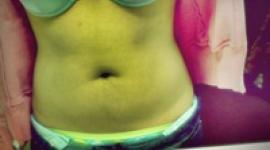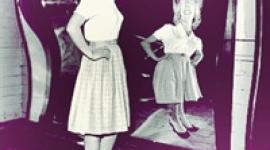Relationships Between Men's and Women's Body Image and Their Psychological, Social, and Sexual Functioning (Part 2)
|
Table I. Height, Weight, and BMI by Gender and Age Group |
|||||||
|
Height (cm) |
Weight (kg) |
Body mass index (BMI) |
|||||
| Age Group |
M |
SD |
M |
SD |
M |
SD |
|
| Women | |||||||
| 18-29 | 165.24 | 7.26 | 63.08 | 12.01 | 23.24 | 4.35 | |
| 30-49 | 164.28 | 7.42 | 71.32 | 17.28 | 26.43 | 6.23 | |
| 50-86 | 162.54 | 7.56 | 69.72 | 13.29 | 26.46 | 5.22 | |
| Overall | 164.00 | 7.44 | 68.63 | 15.13 | 25.60 | 5.63 | |
| Men | |||||||
| 18-29 | 179.68 | 8.03 | 74.87 | 12.48 | 23.18 | 3.55 | |
| 30-49 | 180.45 | 7.22 | 83.72 | 14.14 | 25.75 | 3.84 | |
| 50-86 | 175.69 | 7.66 | 82.26 | 12.66 | 26.65 | 3.30 | |
| Overall | 178.34 | 7.87 | 79.84 | 13.56 | 25.13 | 3.86 | |
|
Table II. Body Image Scores by Gender and Age Group |
|||||
|
Physical attractiveness |
Body image satisfaction |
||||
| Group |
M |
SD |
M |
SD |
|
| Gender | |||||
| Women | 18.57 | 3.51 | 31.23 | 8.56 | |
| Men | 18.51 | 3.57 | 35.46 | 7.21 | |
| Age | |||||
| 18-29 | 19.80 | 3.68 | 33.41 | 7.56 | |
| 30-49 | 18.11 | 3.49 | 31.73 | 8.82 | |
| 50-86 | 18.00 | 3.24 | 34.80 | 7.95 | |
|
Body Image Importance |
Body concealment |
||||
| Group | M | SD | M | SD | |
| Gender | |||||
| Women | 32.00 | 7.44 | 15.40 | 5.72 | |
| Men | 30.94 | 7.61 | 9.77 | 4.73 | |
| Age | |||||
| 18-29 | 30.83 | 7.93 | 12.12 | 5.12 | |
| 30-49 | 31.60 | 7.03 | 14.07 | 6.39 | |
| 50-86 | 31.93 | 7.77 | 11.91 | 6.07 | |
|
Body improvement |
Social physique anxiety |
||||
| Group | M | SD | M | SD | |
| Gender | |||||
| Women | 9.22 | 3.74 | 34.50 | 9.46 | |
| Men | 8.70 | 3.70 | 27.68 | 8.11 | |
| Age | |||||
| 18-29 | 9.40 | 3.41 | 32.47 | 9.27 | |
| 30-49 | 9.05 | 3.38 | 32.92 | 9.95 | |
| 50-86 | 8.62 | 3.45 | 28.25 | 8.45 | |
|
Appearance comparison |
|||||
| Group | M | SD | |||
| Gender | |||||
| Women | 10.98 | 3.29 | |||
| Men | 9.17 | 3.35 | |||
| Age | |||||
| 18-29 | 11.00 | 3.48 | |||
| 30-49 | 10.64 | 3.25 | |||
| 50-86 | 8.76 |
3.18 |
|||
|
Table III. Unique Body Image Predictors From Regression Equations |
|||
| Unique body | |||
| Outcome variable | Group | image predictors | [sr.sup.2] |
| Self-esteem | Women 18-29 | None | -- |
|
Women 30-49 |
Social physique anxiety | .06 | |
|
Body Image Importance |
.05 | ||
|
Women 50-86 |
Physical attractiveness | .13 | |
|
Men 18-29 |
Physical attractiveness | .07 | |
|
Body image importance |
.07 | ||
|
Men 30-49 |
Body concealment | .10 | |
|
Men 50-86 |
Appearance comparison | .08 | |
|
Body image satisfaction |
.07 | ||
| Depression | Women 50-86 | Social physique anxiety | .08 |
| Anxiety | Women 50-86 | None | -- |
|
Men 50-86 |
Appearance comparison |
.11 | |
|
Table IV. Unique Body Image Predictors From Regression Equations |
|||
|
Unique body |
|||
| Outcome variable | Group | image predictors | [sr.sup.2] |
| Social anxiety | Women 50-86 | Social physique anxiety | .08 |
|
Body improvement |
.07 | ||
|
Men 30-49 |
Appearance comparison | .08 | |
| Same-sex relations | Men 30-49 | Physical attractiveness | .13 |
| Opposite-sex relations | Men 18-29 | Body concealment | .09 |
| Sexual self-efficacy | Men 30-49 | Body satisfaction | .09 |
| Sexual satisfaction | Men 30-49 | Appearance comparison | .12 |
|
Body concealment |
.10 | ||
|
Body satisfaction |
.08 | ||
| Sexual optimism | Women 30-49 | None | -- |
|
Men 30-49 |
Social physique anxiety | .18 | |
SOURCES:
Abell, S., & Richards, M. (1996). The relationship between body shape dissatisfaction and self-esteem: An investigation of gender and class differences. Journal of Youth and Adolescence, 25, 691-703.
Allaz, A. F., Bernstein, M., Rouget, P., Archinard, M., & Morabia, A. (1998). Body weight preoccupation in middle-age and ageing women: A general population survey. International Journal of Eating Disorders, 23, 287-294.
Allgood-Merten, B., Lewinsohn, P. M., & Hops, H. (1990). Sex differences and adolescent depression. Journal of Abnormal Psychology, 99, 55-63.
Australian Bureau of Statistics. (1998). How Australians measure up. Canberra, Australia: Australian Bureau of Statistics.
Banfield, S. S., & McCabe, M. P. (2002). An evaluation and clinical implications of the construct of body image. Adolescence, 37, 373-394.
Beebe, D. W. (1995). The Attention to Body Shape Scale: A new measure of body focus. Journal of Personality and Assessment, 65, 486-501.
Bemben, M. G., Massey, B. H., Bemben, D. A., Boileau, R. A., & Misner, J. E. (1998). Age-related variability in body composition methods for assessment of percent fat and fat-free mass in men aged 20-74 years. Age and Ageing, 27, 147-153.
Ben-Tovim, D. I., & Walker, M. K. (1994). The influence of age and weight on women's body attitudes as measured by the Body Attitudes Questionnaire (BAQ). Journal of Psychosomatic Research, 38, 477-481.
Berscheid, E., Dion, K., Walster, E., & Walster, G. W. (1971). Physical attractiveness and dating choice: A test of the matching hypothesis. Journal of Experimental and Social Psychology, 7, 173-189.
Boggiano, A. K., & Barrett, M. (1991). Gender differences in depression in college students. Sex Roles, 25, 595-605.
Coakes, S. J., & Steed, L. G. (1999). SPSS: Analysis without anguish: Versions 7.0, 7.5, 8.0 for Windows. Brisbane, Australia: Jacaranda Wiley.
Davison, T. E. (2002). Body image and psychological, social, and sexual functioning. Unpublished doctoral dissertation. Deakin University, Melbourne, Victoria, Australia.
Denniston, C., Roth, D., & Gilroy, F. (1992). Dysphoria and body image among college women. International Journal of Eating Disorders, 12, 449-452.
Drewnowski, A., & Yee, D. K. (1987). Men and body image: Are males satisfied with their body weight? Psychosomatic Medicine, 49, 626-634.
Eklund, R. C., Kelley, B., & Wilson, P. (1997). The Social Physique Anxiety Scale: Men, women, and the effects of modifying item 2. Journal of Sport and Exercise Psychology, 19, 188-196.
Faith, M. S., & Schare, M. L. (1993). The role of body image in sexually avoidant behavior. Archives of Sexual Behavior, 22, 345-356.
Feingold, A. (1992). Good-looking people are not what we think. Psychological Bulletin, 111, 304-341.
Feingold, A., & Mazzella, R. (1998). Gender differences in body image are increasing. Psychological Science, 9, 190-195.
Halliwell, E., & Dittmar, H. (2003). A qualitative investigation of women's and men's body image concerns and their attitudes toward aging. Sex Roles, 49, 675-684.
Harmatz, M. G., Gronendyke, J., & Thomas, T. (1985). The under-weight male: The unrecognized problem group of body image research. Journal of Obesity and Weight Regulation, 4, 258-267.
Hart, E. A., Leary, M. R., & Rejeski, W. J. (1989). The measurement of social physique anxiety. Journal of Sport and Exercise Psychology, 11, 94-104.
Harter, S. H. (1999). The construction of the self: A development perspective. New York: Guilford.
Holmes, T., Chamberlin, P., & Young, M. (1994). Relations of exercise to body image and sexual desirability among a sample of university students. Psychological Reports, 74, 920-922.
Hoyt, W. D., & Kogan, L. R. (2001). Satisfaction with body image and peer relationships for males and females in a college environment. Sex Roles, 45, 199-215.
Koenig, L. J., & Wasserman, E. L. (1995). Body image and dieting failure in college men and women: Examining links between depression and eating problems. Sex Roles, 32, 225-249.
Lovibond, P. F., & Lovibond, S. H. (1995). The structure of negative emotional states: Comparison of the Depression Anxiety Stress Scales (DASS) with the Beck Depression and Anxiety Inventories. Behaviour Research and Therapy, 33, 335-343.
Mable, H. M., Balance, W. D. G., & Galgan, R. J. (1986). Body-image distortion and dissatisfaction in university students. Perception and Motor Skills, 63, 907-911.
Marsh, H. W. (1997). The measurement of physical self-concept: A construct validation approach. In K. R. Fox (Ed.), The physical self: From motivation to well-being (pp. 27-58). Champaign, IL: Human Kinetics.
Marsh, H. W. (1989). Age and sex effects in multiple dimensions of self-concept: Preadolescence to early adulthood. Journal of Educational Psychology, 81, 417-430.
Martin, K. A., Rejeski, J. W., Leary, M. R., McAuley, E., & Bane, S. (1997). Is the Social Physique Anxiety Scale really multidimensional? Conceptual and statistical arguments for a unidimensional model. Journal of Sport and Exercise Psychology, 19, 359-367.
McCarthy, M. (1990). The thin ideal, depression, and eating disorders in women. Behaviour Research and Therapy, 28, 205-225.
Mintz, L. B., & Betz, N. E. (1986). Sex differences in the nature, realism, and correlates of body image. Sex Roles. 15, 85-98.
Mitchell, K. R., & Orr, F. E. (1976). Heterosexual social competence, anxiety, avoidance, and self-judged physical attractiveness. Perceptual and Motor Skills, 43, 553-554.
Monteath, S. A., & McCabe, M. P. (1997). The influence of societal factors on female body image. Journal of Social Psychology, 137, 708-727.
Montepare, J. M. (1996). An assessment of adults' perceptions of their psychological, physical, and social ages. Journal of Clinical Geropsychology, 2, 117-128.
Motl, R. W., & Conroy, D. E. (2000). Validity and factorial invariance of the Social Physique Anxiety Scale. Medicine and Science in Sports and Exercise, 32, 1007-1017.
Nezlek, J. B. (1988). Body image and day-to-day social interaction. Journal of Personality, 67, 793-817.
O'Brien, E. J., & Epstein, S. (1988). MSEI: The Multidimensional Self-Esteem Inventory. Odessa, FL: Psychological Assessment Resources.
Paxton, S. J., & Phythian, K. (1999). Body image, self-esteem, and health status in middle and later adulthood. Australian Psychologist, 34, 116-121.
Petrie, T. A., Diehl, N., Rogers, R. L., & Johnson, C. L. (1996). The Social Physique Anxiety Scale: Reliability and construct validity. Journal of Sport and Exercise Psychology, 18, 420-425.
Pliner, P., Chaiken, S., & Flett, G. L. (1990). Gender differences in concern with body weight and physical appearance over the life span. Personality and Social Psychology Bulletin, 16, 263-273.
Powell, M. R., & Hendricks, B. (1999). Body schema, gender, and other correlates in nonclinical populations. Genetics, Social, and General Psychology Monographs, 125, 333-412.
Ricciardelli, L. A., & McCabe, M. P. (2001). Self-esteem and negative affect as moderators of sociocultural influences on body dissatisfaction, strategies to decrease weight, and strategies to increase muscles among adolescent boys and girls. Sex Roles, 44, 189-207.
Rodin, J., Silberstein, L., & Striegel-Moore, R. (1985). Women and weight: A normative discontent. In T. B. Sonderegger (Ed.), Psychology and gender: Nebraska symposium on motivation, 1984 (pp. 277-307). Lincoln, NE: University of Nebraska Press.
Rosen, J. C., Srebnik, D., Saltzberg, E., & Wendt, S. (1991). Development of a Body Image Avoidance Questionnaire. Psychological Assessment, 3, 32-37.
Rosenberg, M. (1965). Society and adolescent self-image. Princeton, NJ: Princeton University Press.
Rosenberg, M. (1979). Conceiving the self. New York: Basic Books.
Sarwer, D. B., Wadden, T. A., & Foster, G. D. (1998). Assessment of body image dissatisfaction in obese women: Specificity, severity, and clinical significance. Journal of Consulting and Clinical Psychology, 66, 651-654.
Scheier, M. F., & Carver, C. S. (1985). The Self-Consciousness Scale: A revised version for use with general populations. Journal of Applied Social Psychology, 15, 687-699.
Silberstein, L. R., Striegel-Moore, R. H., Timko, C., & Rodin, J. (1986). Behavioral and psychological implications of body dissatisfaction: Do men and women differ? Sex Roles. 19, 219-232.
Snell, W. E., Jr. (1995). The Multidimensional Sexual Self-Concept Questionnaire. In C. M. Davis, W. L. Yarber, R. Bauseman, G. Schree, & S. L. Davis (Eds.), Handbook of sexuality-related measures (pp. 521-524), Newbury Park, CA: Sage.
Snell, W. E., Jr. (2001). Measuring multiple aspects of the sexual self-concept: The Multidimensional Sexual Self-Concept Questionnaire. In W. E. Snell. Jr. (Ed.), New directions in the psychology of human sexuality: Research and theory. Cape Girardeau, MO: Snell. Electronic book retrieved December 2004 from: http://cstl-cla.semo.edu/snell/books/sexuality/sexualtity.htm
Stormer, S. M., & Thompson, J. K. (1996). Explanations of body image disturbance: A test of maturational status, negative verbal commentary, social comparison, and sociocultural hypothesis. International Journal of Eating Disorders, 19, 193-202.
Stowers, D. A., & Durm, M. W. (1996). Does self-concept depend on body image? A gender analysis. Psychological Reports, 78, 643-646.
Thompson, J. K., Heinberg, L., & Tantleff, S. (1991). The Physical Appearance Comparison Scale (PACS). Behavior Therapy, 14, 174.
Tiggemann, M. (1994). Gender differences in the interrelationships between weight dissatisfaction, restraint, and self-esteem. Sex Roles, 30, 319-330.
Walster, E., Aronson. V., & Abrahams, D. (1966). Importance of physical attractiveness in dating behavior. Journal of Personality and Social Psychology, 4, 508-516.
Wiederman, M. W., & Hurst, S. R. (1997). Physical attractiveness, body image, and women's sexual self-schema. Psychology for Women Quarterly, 21, 567-80.
Tanya E. Davison (1) and Marita P. McCabe (1,2)
(1) School of Psychology, Deakin University, Melbourne, Australia.
APA Reference
Staff, H.
(2005, April 2). Relationships Between Men's and Women's Body Image and Their Psychological, Social, and Sexual Functioning (Part 2), HealthyPlace. Retrieved
on 2025, December 27 from https://www.healthyplace.com/sex/body-image/relationships-between-mens-and-womens-body-image-2


